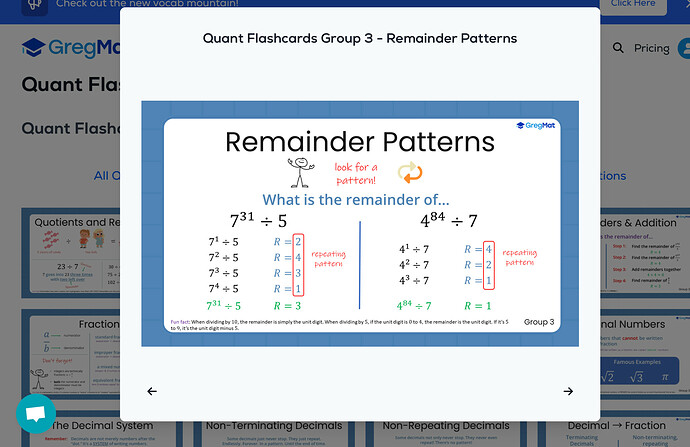Hello guys. I’m having trouble understanding where the remainder is coming from and how to relate the exponent in the question to the pattern. Got this from Greg at quant flash cards. How do you know that 7^31/5 has a remainder of 4, what does that have to do with 7^3/5?
Pattern recognition. Notice that the remainders of 7^x follow a consistent pattern. You use this to your advantage.
I hardly understood the Prepswift videos titled ‘Remainders and Exponents’ and ‘Remainders and Addition’. Could you please help?
Be more specific - what in that do you not understand?
Finding the remainder of a fraction when the numerator has an exponent. Pretty much everything aside when 10 is the denominator.
Let’s try this: suppose we want to divide 3^{55} with 5. What information do we need to solve this problem?
Identifying a pattern in the unit digits of the exponents of 3?
After watching the video once more, I now understand cases where 2, 3 and 4 and 10 are the divisors.
If the remainder for the fraction above is 2, then I think I also understand how to get the remainder when dividing by 5. Here is how I did it:
3 exp 1: 3 3 exp 5: 3
3 exp 2: 9 3 exp 6: 9
3 exp 3: 7 3 exp 7: 7
3 exp 4: 1 3 exp 8: 1
From the pattern, I deduced that whenever the exponent is a multiple of 4, the resulting number will have a unit digit of 1. Hence, 3 exp 52 will result in a number with a unit digit of 1. I used the pattern to conclude that 3 exp 55 will result in a number with a unit digit 7 (I just realized that, alternatively, I could have worked my way down from 3 exp 56, which is shorter). Since the unit digit is 7, remainder is 7- 5 = 2, right? So if I get the rules for 5 correctly, the remainder equals the unit digit if the unit digit is less than 5. If the unit digit is more than 5, the remainder equals the unit digit minus 5. What then happens when the unit digit is 5? Is the remainder 0?
Yes.
Thanks a lot.
I am still a little confused about this question. 31 is a prime number, therefore, it’s not a multiple of 1,2,3, or 4. 30, however, is a multiple of 3. Wouldn’t we go 1 down from 3 to get to 31 (meaning we would end up at 7^4 which has a remainder of 1)?
Not sure what you mean? 31 being prime or not has no bearing on the problem.
Once we identify the pattern, we apply this pattern to larger exponents. However, I was confused because 31 is not a multiple of 1,2,3, or 4. Therefore, I wasn’t sure how to apply this pattern. I think I figured it out though. 30 is a multiple of 2, therefore, an exponent of 30 would follow the same pattern that the exponent of 2 follows. Moving one down, we would find the pattern that the exponent of 31 would follow (which is remainder 3).
I don’t get your logic.
I don’t get your logic either, but I’m more or less positive that what you said doesn’t really check out. It’s best for u to clarify so that you can clear your misconceptions. Can you solve a particular example question and then show that instead?
Yes, that’s a good point because my logic failed me when answering this question from a Prepswift quiz.
I don’t think I understand the process of solving remainder problems. Could you take me through the steps of the problem I posted below please. Thank you!
Try writing the remainders you get when 3^x (1 \leq x \leq 8) is divided by 7.
Remainders:
(3^1)/(7) = 3
(3^2)/(7) = 2
(3^3)/(7) = 6
(3^4)/(7) = 4
(3^5)/(7) = 5
(3^6)/(7) = 1
(3^7)/(7) = 3
(3^8)/(7) = 2
Are you seeing a pattern come up? What if we try 3^9 and 3^{10}?
Yes, I see a pattern
(3^9)/(7) = 6
(3^10)/(7) = 4
What I’m having trouble with is determining which pattern a larger exponent would follow. Say, 3^31 or 3^107.
Well the pattern is (3,2,6,4,5,1) so extrapolate which “position” the 31st and 107th term would be.
For example, 3^7 is in the “first position” cuz it’s 1 term after a group of 6 ( the pattern above), so it leaves remainder 3

